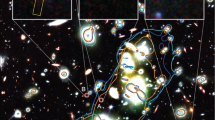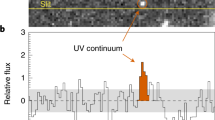Abstract
Observations of distant galaxies are important both for understanding how galaxies form and for probing the physical conditions of the Universe at early times. It is, however, very difficult to identify galaxies at redshifts z > 5, because they are so faint and have few spectral characteristics. We previously reported1 the probable identification of a galaxy at z = 6.68, based on one line and an apparent break in the spectrum just shortwards of that, which we interpreted as Lyman α emission and the Lyman α break, where photons with shorter wavelengths are absorbed by the intervening neutral hydrogen gas. Here we present optical photometry that shows moderate detections of light in the B- and V-band images, which are inconsistent with the expected absence of flux shortwards of the Lyman α break for a galaxy at z > 5, and inconsistent with the previous flux measurement. Moreover, the spectral energy distribution for this object cannot readily be fitted by any known galaxy spectral template at any redshift, so the redshift is undetermined.


Similar content being viewed by others
References
Chen, H.-W., Lanzetta, K. M. & Pascarelle, S. A spectroscopically identified galaxy of probable redshift z = 6.68. Nature 398, 586–588 (1999).
Yahata, N. et al. Photometry and photometric redshifts of faint galaxies in the Hubble deep field south NICMOS field. Astrophys. J. 538, 493–504 (2000).
Puetter, R. C. & Yahil, A. in The Astronomical Data Analysis Software and Systems (ADASS) VIII Conference (eds Mehringer, D. M., Plante, R. L. & Roberts, D. A.) Vol. 172, 307–316 (Astronomical Society Publications, ASP, San Francisco, 1999).
Fernández-Soto, A., Lanzetta, K. M. & Yahil, A. A new catalog of photometric redshifts in the Hubble deep field. Astrophys. J. 513, 34–50 (1999).
Holtzman, J. A. et al. The photometric performance and calibration of WFPC2. Publ. Astron. Soc. Pacif. 107, 1065–1093 (1995).
Schmidt, B. P. et al. The high-z supernova search: measuring cosmic deceleration and global curvature of the universe using type Ia supernovae. Astrophys. J. 507, 46–63 (1998).
Author information
Authors and Affiliations
Corresponding author
Rights and permissions
About this article
Cite this article
Chen, HW., Lanzetta, K., Pascarelle, S. et al. Unusual spectral energy distribution of a galaxy previously reported to be at redshift 6.68. Nature 408, 562–564 (2000). https://doi.org/10.1038/35046031
Received:
Accepted:
Issue Date:
DOI: https://doi.org/10.1038/35046031
- Springer Nature Limited
This article is cited by
-
Inhibiting β-Amyloid-Associated Alzheimer’s Pathogenesis In Vitro and In Vivo by a Multifunctional Dimeric Bis(12)-hupyridone Derived from Its Natural Analogue
Journal of Molecular Neuroscience (2015)
-
Different pathways of molecular pathophysiology underlie cognitive and motor tauopathy phenotypes in transgenic models for Alzheimer’s disease and frontotemporal lobar degeneration
Cellular and Molecular Life Sciences (2015)
-
Modulation of AMPA receptor function by auxiliary subunits
e-Neuroforum (2015)
-
Andrographolide reduces cognitive impairment in young and mature AβPPswe/PS-1 mice
Molecular Neurodegeneration (2014)
-
Choroid plexus implants rescue Alzheimer’s disease-like pathologies by modulating amyloid-β degradation
Cellular and Molecular Life Sciences (2014)





